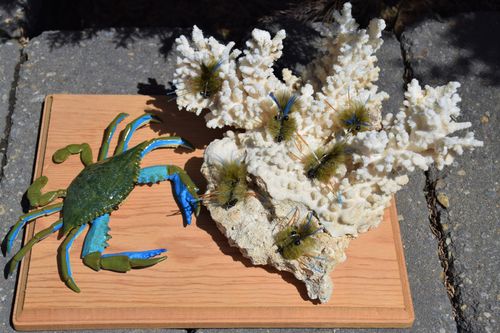
Keel Crab

Designed to catch permit, bonefish and redfish, this crab pattern has proven effective throughout the Mexican Yucatan, Belize, Cuba, and Louisiana. The secret? The brass beads on the keel which not only add the right amount of weight to the fly, but also ensure the fly descends at the correct angle and sits in a defensive position once it reaches the bottom.
Materials
Hook: Gamakatsu SC 15, Size 1/0Thread: UTC Ultra 140 brown olive
Weight: Keel – Four 1/8” black brass beads; Head – 5/32” black brass dumbbell eyes
Claws: Olive grizzly marabou; Dyed blue wood duck
Flash: Pearl krystal flash
Eyes: Large black mono eyes
Keel: 20 lb Mason hard mono
Body: Eel green 3D EP Fibers
Legs: Fly Enhancer Legs light blue/pumpkin
Adhesive: Zap-a-Gap ‘Brush On’
Tying Instructions
Step 1.
Insert the hook in the vise and attach the thread two hook eye lengths behind the eye.
Step 2.
Run a bead of Zap-A-Gap along the thread wraps and then tie in the dumbbell eyes onto the top of the hook shank using figure-eight wraps (This fly rides hook point up).
Step 3.
Wrap a thread base back to the point where the bend starts. Double over two pieces of krystal flash and tie them in so that four strands extend off the back of the hook one and a half hook shanks in length.
Step 4.
Next, tie in two grizzly marabou feathers so they also extend off the back of the hook the length of one hook shank.
Step 5a.Strip half the fibers from a wood duck feather and tie them in along one side of the marabou. Make sure they curve away from the marabou, creating the illusion of claws.
Step 5b.
Strip the other half of the wood duck feather and repeat by tying those fibers in along the other side of the marabou.
Step 6.
Wrap the thread back to the point behind the dumbbell eyes. Cut a 3” long piece of 20 lb Mason monofilament and lay it on top of the hook shank so that it extends back over the marabou. Wrap back towards the hook bend covering the monofilament. Make sure to bind it securely to the hook shank, stopping the thread opposite the barb of the hook.
Step 7.
Invert the fly in the vice and tie in the mono eyes with several figure-eight wraps making sure they stick out at a 45-degree angle.
Step 8.
Select several bunches of EP fibers, about the diameter of a wooden match stick, and cut them into smaller pieces 3-4 cm (1-2 inches) in length.
Step 9.
Using figure-eight wraps, tie a piece of the EP fibers onto the hook shank at a 90-degree angle and as close to the mono eyes as possible. Lock the fiber bunch down with several wraps in front.
Step 10.
Select three strands of Fly Enhancer Legs and cut them in half. Tie in one pair of legs, using figure-eight wraps, and making sure that it butts up against the EP fibers as closely as possible.
Step 11.
Repeat this EP fiber/leg pair tie-in sequence until you have tied in three sets of legs and built up a body that butts up against the dumbbell eyes. You will get a nicely proportioned body if you have two segments of EP fiber between every pair of legs.
Step 12.
Tie off and cut the thread at the eye of the hook.
Step 13.
Using a pair of curved scissors, carefully trim the EP fiber body into a roughly circular shape using a Canadian nickel as a size guide. Make sure to keep the legs out of the way so they do not accidentally get cut off. Do not worry if the crab body is slightly lopsided as real crabs are not perfectly round either.
Step 14.
Trim the Fly Enhancer Legs so they are all roughly the same length.
Step 15.
Restart the thread at the head of the fly.
Step 16.
String four brass beads onto the mono keel, bend the monofilament keel over the dumbbell eyes and tie off right at the eye of the hook. Cut the excess monofilament piece.
Step 17.
Whip finish your thread and coat all your visible thread wraps with Zap-a-Gap for durability.
Your Keel Crab is now complete and you are ready to head out On The Water!



